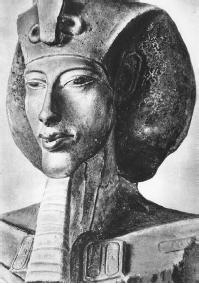Egyptian Mystery Schools
Akhenaten
Some scholars credit the pharaoh Amenhotep IV, who ruled Egypt (c. 1358–1340 B.C.E.), with being an astonishing visionary who conceived of monotheism in a time when multiple gods flourished. Amenhotep IV chose to call himself Akhenaten. Because of his revolutionary religious views, his contemporaries chose to call him "heretic," and he remains a controversial historical figure to this day.
During the so-called Old Kingdom period of Egyptian history (c. 2700–2185 B.C.E.), pharaohs were considered to be divine, representatives of the many gods of ancient Egypt, and the earthly incarnation of the "Great God," the sun god, Ra. During the Middle Kingdom (c. 2000–1785 B.C.E.) when the Egyptian power base shifted from Heliopolis, near the junction of Upper and Lower Egypt, to Thebes in Upper Egypt, the Theban god "Amun" became combined with Ra to become Amun-Ra. Although he was generally depicted in human form, Amun-Ra was still considered the Great God/Creator Being and still identified with the sun, and since Egypt under the Theban kings entered into a period of great power and posterity, he was esteemed as a mighty and benevolent god.
When Amenhotep IV became pharoah about the year 1367 B.C.E., he inherited his

Akhenaten insisted upon naturalism in all of Egyptian life, including its artistic representation of the pharoah and his family. Such a command to portray only truth in art gave posterity a unique portrait of this religious reformer who so jarred history. While the portraits and the famous statue of his queen, Nefertiti, have allowed her to be recognized as one of the great beauties of the ages, the king himself appears to have been far from majestic in appearance. Narrow-shouldered and pear-shaped in body, his head is abnormally elongated with a drooping jaw. Only in his mysterious, pensive eyes does one glimpse a fleeting shadow of the soul that sought to persuade a kingdom to understand his belief in monotheism.
For the 17 or so years of his reign, Akhenaten was so absorbed in preaching his new faith that he sought to conquer no new territories—nor did he heed the reports of his military commanders and allies to shore up the defenses of Egypt's borders. To the dismay of those who had grown wealthy with the expansion of the Egyptian empire, Akhenaten was not the great warrior-pharoah that so many of his predecessors to the throne had been. Neither was he an effective missionary, for the angry, dispossessed priests of Amun and the outcast servants of the many other gods only bided their time to resume control of the spiritual needs of the Egyptian people. While some scholars maintain that Akhenaten's experiment in monotheism has had lasting effect upon the religions of today, the cult of Aten appeared to have had no real lasting effect upon the religious framework of Egypt.
Recent scholarship has suggested that about the twelfth year of his reign, Nefertiti and Akhenaten became estranged and that he may have taken another queen who might bear him a son. Others have argued he elevated his son-in-law Smenkhkare to share the throne with him in a kind of co-rulership capacity. Still other scholars have debated that Nefertiti herself ascended the throne after Akhenaten died a natural death or was killed by those who condemned him as a heretic. All that is certain is that the son-in-law who succeeded Akhenaten soon changed his name from Tutankhaten to Tutankhamun, thereby indicating his allegiance to the Theban god of Amun, rather than Aten, the god of Akhenaten. It is also evident that the priests and followers of Amun achieved their revenge on the heretic pharoah by obliterating his name and the name of his god from all monuments, statues, temples, and city walls throughout Egypt.
In 1907, a mummy was found in a violated tomb in the Biban-el-Moluk that some Egyptologists theorized might well contain the remains of Akhenaten. While such claims have not yet been verified, perhaps modern pathology might one day solve another controversy that has been provoked by the mystical pharoah.
User Contributions:
Comment about this article, ask questions, or add new information about this topic:
Egyptian Mystery Schools forum
